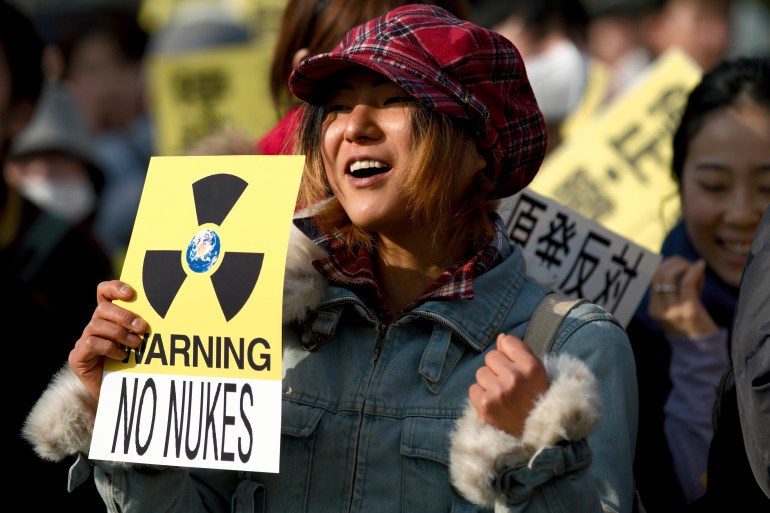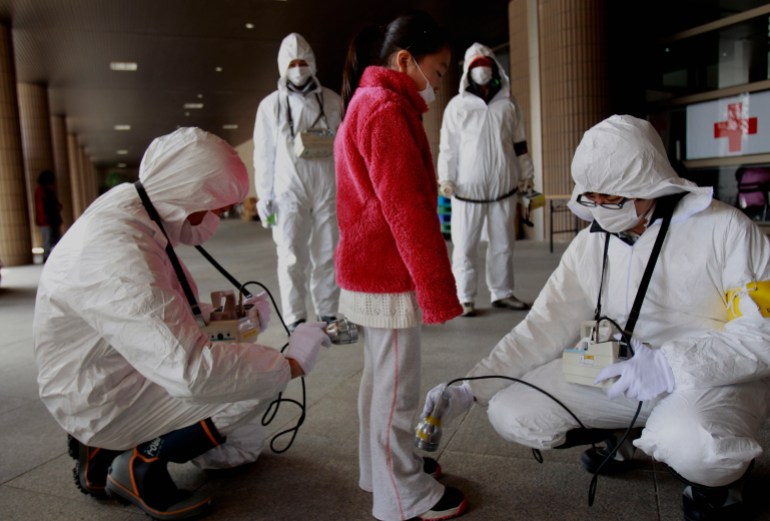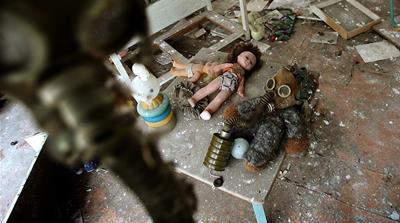WORD NEWS
Does India have sufficient insurance coverage protection for a nuclear catastrophe? | Nuclear Power
India has barely half the insurance coverage quantity it wants within the occasion of a nuclear catastrophe, elevating considerations amongst consultants in regards to the lack of oversight on the nuclear sector.
The India Nuclear Insurance coverage Pool (INIP) has collected round 7 billion to eight billion rupees ($84.5m to $96.6m) of the 15 billion rupees ($182.9m) required below the Civil Legal responsibility for Nuclear Harm Act, 2010 (CLND), indicating a vital shortfall in funds that will probably be wanted to compensate victims and pay for cleanup in case of a nuclear catastrophe.
The funds disclosure was made on the nuclear insurance coverage session of the India Nuclear Enterprise Platform in December the place the audio system included representatives of Nuclear Energy Company of India Restricted (NPCIL), which operates the nation’s nuclear reactors, and main insurance coverage corporations together with New India Assurance and GIC Re.
The INIP was arrange in 2015 below the CLND laws. Below that legislation, operators and suppliers of nuclear energy crops are liable in case of an accident, and each should get hold of insurance coverage by way of the INIP.
On the time, India’s Division of Atomic Power in its continuously requested questions (FAQs) on the CLND Act said that GIC Re and 4 different public sector insurers would collectively contribute half of the whole required quantity of 15 billion rupees ($182.9m), with the federal government filling within the stability for the primary few years “until the insurance coverage corporations are capable of preserve it on their very own”.
“The truth that the nuclear insurance coverage pool has not even met what’s required by legislation is regarding — it exhibits that the Parliament is just not overseeing how the nuclear sector is working,” stated MV Ramana, professor on the Faculty of Public Coverage and International Affairs, College of British Columbia and writer of The Energy of Promise: Inspecting Nuclear Power in India. “My larger concern is the method of NPCIL and different events concerned, which appear to consider legal responsibility necessities as a field to test off, somewhat than one thing they should prudently plan for.”
“They appear to be victims of the identical ‘security fable’ that was on the root of the insufficient preparations for nuclear accidents revealed within the aftermath of the a number of reactor accidents on the Fukushima Daiichi nuclear plant in Japan [in March 2011],” Ramana stated.
India at present has 22 reactors, all of that are operated by the NPCIL. The INIP gives insurance coverage to all of them. Aside from this, it has 10 reactors which are at numerous phases of building (considered one of which has been linked to the grid) and New Delhi has sanctioned one other 10 — all of that are anticipated to start out functioning by 2031. However how these crops will probably be insured is unknown.
Nuclear swimming pools

Nuclear swimming pools had been first arrange within the Nineteen Fifties in the US by insurance coverage corporations to take care of potential accidents at civilian nuclear reactors. A lot of insurers come collectively to collectively underwrite civil nuclear dangers since a nuclear accident has catastrophic potential with monumental prices – past the capability of particular person threat insurers to tackle.
The INIP, which is made up of India’s nationwide re-insurance firm GIC Re in affiliation with 11 home non-life insurance coverage corporations, is managed GIC Re. Of the quantity raised, public sector insurance coverage corporations have to date contributed 86 %, with personal insurance coverage corporations bringing in the remainder. GIC Re’s contribution is the most important, with 6 billion rupees ($73m).
The opposite public sector insurance coverage corporations within the pool are New India Insurance coverage, United India Insurance coverage, Oriental Insurance coverage and Nationwide Insurance coverage Co Ltd. The personal sector corporations embody ICICI Lombard Common Insurance coverage, Reliance Common Insurance coverage, Tata AIG Common Insurance coverage, IFFCO-Tokio Common Insurance coverage, Cholamandalam Common Insurance coverage, SBI Common Insurance coverage and Common Sompo Common Insurance coverage.
The issue of Indian insurance coverage corporations’ lack of ability to pay for nuclear legal responsibility insurance coverage has been brewing since a minimum of 2014, after they signalled their lack of ability to lift greater than 7.5 billion rupees ($91.4m), or half the quantity required. Below worldwide norms, each time an insurance coverage firm creates an insurance coverage pool in a brand new space of enterprise, it can’t set aside greater than three % of its internet price and ask the federal government to make up for the shortfall. Since 2014, nonetheless, consultants level to an absence of re-insurance for nuclear threat legal responsibility as one of many probably causes for corporations failing to pay their full share.
“The insurance coverage corporations might need paid their share if the reinsurance market had supported them,” stated Shreyas Jayasimha, co-founder of Banglaore-based Aarna Legislation. “Simply as people search insurance coverage for his or her dangers, insurance coverage corporations too require to cowl their dangers.”
Insufficient cowl
There may be additionally concern about whether or not the insurance coverage cowl of 15 billion rupees ($182.9m) is sufficient to insure all of NPCIL’s 22 reactors yearly.
“If there’s a nuclear incident the place the annual restrict of 15 billion rupees of the coverage issued below INIP is partially or utterly utilised, the opposite nuclear installations can be with out full or any cowl for that yr,” stated Pallavi Bedi, associate at Phoenix Authorized and a specialist in power initiatives.

The Indian nuclear pool’s genesis could be traced to a 2008 settlement between India and the US for civilian nuclear cooperation. Below the settlement, India was allowed to start out importing nuclear know-how and supplies and enabled the entry of personal companies into the Indian civilian nuclear market.
However India lacked a regime that assigned authorized legal responsibility within the occasion of a nuclear accident. The CLND Act 2010 was introduced in to resolve that, amidst a lot debate and wrangling within the Indian Parliament. The query of whether or not suppliers needs to be held liable emerged as a severe level of rivalry, with critics in India accusing the federal government of offering a protect to US companies in an effort to get them on board as suppliers, on the expense of Indian residents.
Fukushima, Chernobyl and Bhopal
Whereas the insurance coverage trade refers to nuclear incidents because the “rarest of uncommon”, the final main nuclear disasters had been in 1986, when there was a leak at a plant in Chernobyl in Ukraine when it was nonetheless part of the Soviet Union, and in 2011, when a serious earthquake and a tsunami brought on a nuclear accident in Fukushima in Japan.
The explosion and hearth on the Chernobyl nuclear reactor launched radioactive materials into the ambiance, affecting hundreds and having ramifications throughout Russia, Belarus, Ukraine and several other European nations. The financial prices of the accident ranged wherever between $235bn and $700bn, together with compensation price lots of of billions of {dollars}, to not point out far-reaching prices to the setting and well being.
The prices of Japan’s Fukushima catastrophe have been estimated at greater than $200bn, of which compensation prices included $72bn. The Fukushima catastrophe displaced hundreds, with cleanup actions persevering with for a decade.
Nearer to dwelling, India’s variant of an industrial catastrophe – the 1984 Bhopal fuel leak – killed greater than 15,000 and brought on severe well being issues in about half one million individuals when a pesticide plant leaked poisonous methyl isocyanate fuel into the ambiance, subjecting generations of individuals to hostile well being results akin to most cancers, congenital malfunctions, and lung and coronary heart illnesses.
Union Carbide Company, a US firm that constructed the damage-causing Bhopal plant, paid a paltry $470m in compensation to victims and their households. Within the US, Union Carbide was altogether cleared of any direct legal responsibility in the direction of victims.
Legal responsibility regimes

So far as the nuclear trade is worried, legal responsibility is normally chanelled in the direction of operators of energy crops whereas suppliers stay shielded. This follow started within the Nineteen Fifties within the US, the place to be able to encourage personal sector participation within the nuclear trade, operators are held virtually wholly liable. Many different nations adopted go well with, with the US additionally influencing the shaping of the worldwide Conference on Supplementary Compensation for Nuclear Harm (CSC). Even when operators are held liable, the financial legal responsibility is capped at a small determine at a fraction of precise prices.
“This cover varies by nation, however is normally set beneath $1 billion — a quantity that’s virtually 100 occasions smaller than the monetary impression of a extreme nuclear accident like Fukushima” the physicists MV Ramana and Suvrat Raju wrote within the New York Occasions.
India’s legal responsibility legal guidelines too fall consistent with the worldwide development, barring Part 17 b of the CLND Act, 2010, which permits the operator the correct of recourse in case the accident is discovered to be “the consequence of an act of provider”, which incorporates the availability of faulty or sub-standard gear or materials.
The operator of nuclear installations in India is the government-run NPCIL. Suppliers – which can not essentially be overseas corporations – present manufacturing, provides, constructing and design providers
In response to insurance coverage corporations, the explanation for together with such a clause is due to “unhealthy experiences” within the aftermath of the Bhopal fuel tragedy.
Legal responsibility past 15 billion rupees ($182.9m)

An up to date model of FAQs on the nuclear legal responsibility act launched by the Division of Atomic Power in 2020 continues to emphasize the operator as the first bearer of legal responsibility as much as 15 billion rupees ($182.9m). In case compensation claims exceed this restrict, the federal government is anticipated to step in.
“In case legal responsibility exceeds 15 billion ($182.9m), the federal government should pay the remainder. The federal government owns and operates the nation’s nuclear energy crops for the individuals and is subsequently accountable to them,” stated Prabir Purkayastha of the Delhi Science Discussion board, who was an knowledgeable witness for the Parliamentary Standing Committee for the Nuclear Security Regulatory Authority Invoice, 2011.
The Indian authorities has additionally restricted the utmost legal responsibility, together with its personal, within the occasion of a nuclear incident, to the rupee equal of 300 million Particular Drawing Rights (SDRs) or over 33 billion rupees ($374m).
SDRs are a worldwide reserve asset created by the Worldwide Financial Fund. The SDR relies on a basket of 5 main currencies, and holders – together with IMF member nations, amongst others – can change SDRs for foreign money when wanted.
If legal responsibility exceeds 300 million SDRs within the occasion of a nuclear mishap, the federal government expects to fulfill stability claims by “entry(ing) worldwide funds below the CSC.” India joined the Conference on Supplementary Compensation for Nuclear Harm (CSC) in 2016.
However how claims would play out on the CSC is unclear.
Extra just lately, India’s Supreme Court docket in a choice that dismissed the federal authorities’s effort to hunt further compensation from Union Carbide within the Bhopal fuel catastrophe stated that it was India’s “accountability” to “make good the deficiency [in compensation] and to take out the related insurance coverage coverage. Surprisingly we’re knowledgeable that no such insurance coverage coverage was taken out. That is gross negligence.”
In response to Jayasimha, the wording of the Supreme Court docket judgement is important for the nuclear trade and all hazardous waste industries. “The courtroom has indicated that there’s a obligation on the a part of the state to make sure individuals are adequately insured.”
For now, it’s unclear if the judgement will probably be used to push for higher insurance coverage provisions.
Inquiries to NPCIL, the Division of Atomic Power, New India Assurance and GIC Re in regards to the failure of the INIP to build up the corpus of 15 billion rupees ($182.9m) and the way the federal government plans to insure forthcoming nuclear reactors didn’t obtain a response.
Managing director of the Nuclear Enterprise Platform, Zaf Coelho, stated through e-mail: “In case of any nuclear catastrophe, the declare quantity exceeding the amassed corpus will probably be shared by the INIP consortium companions on a pro-rata foundation primarily based on their dedicated share within the pool.”
Trending
-
Bank and Cryptocurrency12 months ago
Cheap Car Insurance Rates Guide to Understanding Your Options, Laws, and Discounts
-
Bank and Cryptocurrency12 months ago
Why Do We Need an Insurance for Our Vehicle?
-

 entertainement6 months ago
entertainement6 months agoHOUSE OF FUN DAILY GIFTS
-
WORD NEWS1 year ago
Swan wrangling and ‘steamy trysts’: the weird lives and jobs of the king’s entourage | Monarchy
